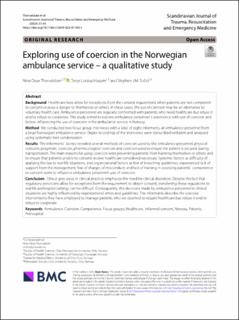| dc.contributor.author | Thorvaldsen, Nina Øye | |
| dc.contributor.author | Husum, Tonje Lossius | |
| dc.contributor.author | Sollid, Stephen J. M. | |
| dc.date.accessioned | 2023-09-18T06:49:11Z | |
| dc.date.available | 2023-09-18T06:49:11Z | |
| dc.date.created | 2023-09-14T14:42:21Z | |
| dc.date.issued | 2023 | |
| dc.identifier.issn | 1757-7241 | |
| dc.identifier.uri | https://hdl.handle.net/11250/3089964 | |
| dc.description.abstract | Background Healthcare laws allow for exceptions from the consent requirement when patients are not competent to consent or pose a danger to themselves or others. In these cases, the use of coercion may be an alternative to voluntary health care. Ambulance personnel are regularly confronted with patients who need healthcare but refuse it and/or refuse to cooperate. This study aimed to explore ambulance personnel`s experience with use of coercion and factors influencing the use of coercion in the ambulance service in Norway. Method We conducted two focus group interviews with a total of eight informants, all ambulance personnel from a large Norwegian ambulance service. Digital recordings of the interviews were transcribed verbatim and analysed using systematic text condensation. Results The informants` stories revealed several methods of coercion used by the ambulance personnel; physical coercion, pragmatic coercion, pharmacological coercion and coercion used to ensure the patient is secured during transportation. The main reasons for using coercion were preventing patients from harming themselves or others and to ensure that patients unable to consent receive healthcare considered necessary. Systemic factors as difficulty of applying the law to real-life situations, and organizational factors as fear of breaching guidelines, experienced lack of support from the management, fear of charges of misconduct, and lack of training in assessing patients´ competence to consent seem to influence ambulance personnels use of coercion. Conclusion Ethical grey areas in clinical practice emphasize the need for clinical discretion. Despite the fact that regulatory provisions allow for exceptions from the requirement to obtain consent, transferring these regulations to real life prehospital settings can be difficult. Consequently, the decisions made by ambulance personnel in clinical situations are highly influenced by organizational ethos and guidelines. The informants describe the coercive interventions they have employed to manage patients who are deemed to require healthcare but refuse it and/or refuse to cooperate. | en_US |
| dc.language.iso | eng | en_US |
| dc.rights | Navngivelse 4.0 Internasjonal | * |
| dc.rights.uri | http://creativecommons.org/licenses/by/4.0/deed.no | * |
| dc.subject | Ambulansetjeneste | en_US |
| dc.subject | Ambulance services | en_US |
| dc.subject | Fokusgrupper | en_US |
| dc.subject | Focus groups | en_US |
| dc.subject | Samtykkekompetanse | en_US |
| dc.subject | Competence to concent | en_US |
| dc.subject | Prehospitale tjenester | en_US |
| dc.subject | EMT | en_US |
| dc.subject | Tvang | en_US |
| dc.subject | Coercion | en_US |
| dc.title | Exploring use of coercion in the Norwegian ambulance service – a qualitative study | en_US |
| dc.type | Peer reviewed | en_US |
| dc.type | Journal article | en_US |
| dc.description.version | publishedVersion | en_US |
| cristin.ispublished | true | |
| cristin.fulltext | original | |
| cristin.qualitycode | 1 | |
| dc.identifier.doi | https://doi.org/10.1186/s13049-023-01104-x | |
| dc.identifier.cristin | 2175175 | |
| dc.source.journal | Scandinavian Journal of Trauma, Resuscitation and Emergency Medicine | en_US |

